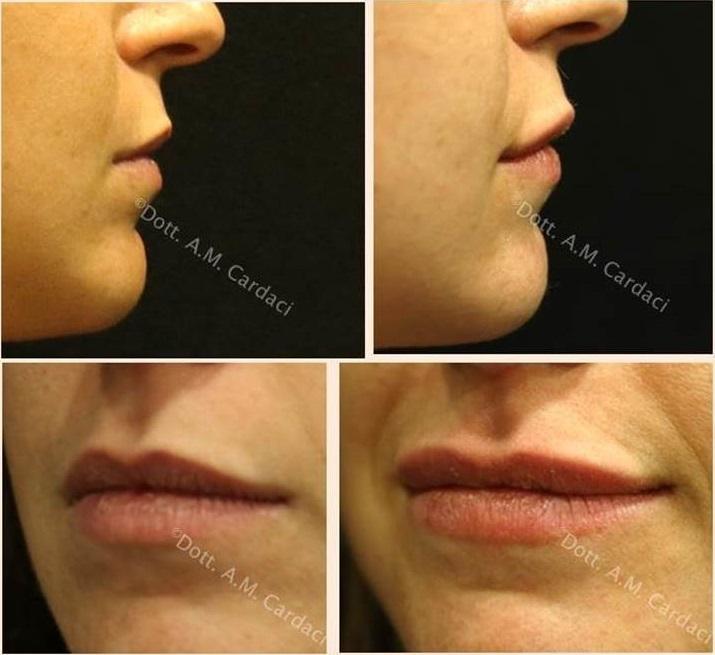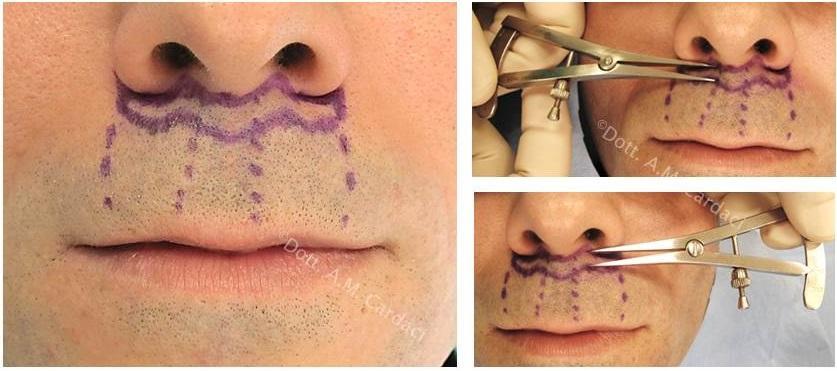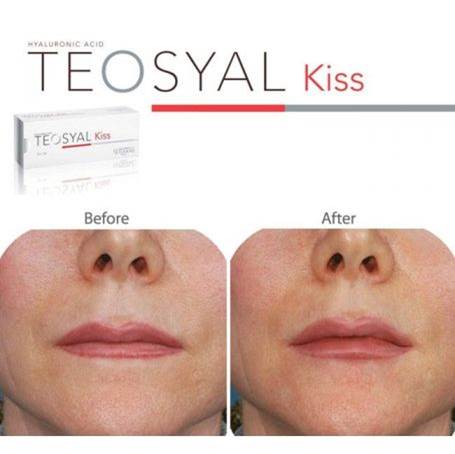LIP FILLER
The lower third of the face represents a fundamental component in expression because it is dominated by the mimicry of the mouth. The lips are a complex structure made up of skin, muscles and mucous membrane. Racial differences determine a physiological variability in the predominance of the vermilion (red lip) over the white lip. Individuals of the Negroid race have, for example, a component of the labial mucosa predominant compared to the Caucasian race, thus already showing plump lips by nature. The lips, in addition to performing their mimic, phonatory and alimentary physiological function, play a very important role in the collective erotic imagination, particularlyforthefemalesex. Unfortunately, nowadays the reference system to which patients who try to “make up their lips” must be confronted is often altered, since the predominant model proposes hypertrophic “remade” lips modifying physiological harmonies of the nasolabial and labiomental angles, as well as normal buccal occlusion.
We distinguish the techniques available to enlarge the lips in two basic approaches:
1) aesthetic medicine treatments
2) lips plastic surgery (cheiloplasty)
Inthefirstgroupweincludehyaluronicacidbased fillers, in the second all the interventional methods that, through a surgical intervention, determine an increase (or greater exposure) of the red lip.
Augmentation cheiloplasty operations are lip lift, prosthesis implantation and lipofilling.
1) AESTHETIC MEDICINE TREATMENT: LIP FILLER
Hyaluronic acid is a biochemical component of the dermal matrix responsible for the tone and elasticity of the skin and mucous membranes of our body. Over time and with aging phenomena, the amount of this component produced is considerably reduced and as a result, structures such as lips lose tone, become thinner, becoming wrinkled and hypotrophic. The revolution of the last 20 years led by aesthetic medicine is based on the production of “areaspecific” fillers with a concentration of crosslinked hyaluronic acid and a consistency that allows it to infiltrate different areas of the face and body.
Specifically, for the lips I use a dedicated filler with a volumizing effect that guarantees a duration of at least 6months.
The infiltration technique involves the use of ice or anesthetic ointment to desensitize the area, then, with a special skin vibratory device that almost completely cancels the pain, infiltration is started with very fine needles. It is useful to underline that the largest volumetric component must always be borne by the lower lip. It will therefore often happen to have patients who require a small infiltration to the upper lip and a greater volume to the lower one to give an extremely natural effect in terms of lip volume gain. In special cases, local anesthesia can also be performed to completely cancel the pain sensation. The treatment lasts about 15 minutes, is not particularly painful thanks to the vibration and does not cause bruising immediately. The patient can immediately return to his activities after treatment. On the second or third day, some small bruising may appear which is easily concealed with cosmetics.
Allergic reactions with this new generation of fillers are not described and the rarely could happen formation of granulomas if there is a technical defect, a problem with the material or a predisposition of the patient. Contraindications: the treatment is not indicated for subjects with acute herpes, pregnant women or subjects who have already had adverse reactions with other local injection therapies.
The costs of a lip filler vary based on the number of vials used and have a range between 300 and 500 euros.
FILLER LABBRA PRE POST

2) PLASTIC SURGERY
a. Lip Lift (sub nasal lip lift)
Surgical technique described more than thirty years ago which involves the removal of the upper portion of the white lip with different designs, with gull wings or bull’s horns

The removal of fullthickness skin and the traction due to the internal sutures results in an elevation of the white lip with a consequent greater exposure of the vermilion. This technique is indicated in subjects who, following a genetic predisposition or aging, show a disproportion in the balance between white and red lips, thus showing thin lips. Another cheiloplasty technique instead involves the incision directly on the edge of the vermilion, with diamondshaped removal of the lateral margins of the upper lip and greater exposure of the vermilion itself.
The operation is performed under local anesthesia, lasts about 30 minutes and the external sutures mustberemovedbetw en5thand6thday.Inthefirstfewdaysthelipmaybeedematous,therefo earest period of at least 23 days is recommended. The scar is almost invisible already after 1520 days. Costs must take into account those of the facility where you work, the possible presence of an anesthesiologist and the help of the surgeon and can vary between 1,500 and 2,500 euros.
b. Lip Implant (Permalip©)
Technological advancement has made available a new concept of silicone lip implant, specifically designed for this region. This prosthesis is soft to the touch, extremely flexible and elastic, mimicking the soft tissue structures of the labial mucosa in an almost perfect manner. This silicone implant has
supplanted the use of old GoreTex© prostheses or other materials that often caused problems and complications. They are available on the market in different lengths and thicknesses, such as to adapt them to the patient’s wishes and anatomical proportions.
The patient who opts for a permanent lip augmentation solution is generally a patient who already has a long history of lip fillers, but may also be a “primary” patient who chooses this method as the first
option. During the first consultation tissues of the lips and their volumetric ratios are studied to decide the size of the prostheses to be implanted. A sample of the implant is then shown to the patient and several examples of previous clinical cases similar to his. Therefore, once the usual analyzes and therapies to be followed have been prescribed, the informed consent to the intervention is read together or it is sent by email for a possible second visit.
On the day of surgery, the patient is fasting, wearing comfortable clothes and without makeup, having already started antiviral and antibiotic prophylaxis. We also generally prescribe mountain arnica whichhasb enshowntobeadecentantiedema.
Cheiloplasty surgery using silicone implants takes place on an outpatient or day hospital basis, preferably with anesthetic assistance for mild sedation. The operation begins with an infraorbital and mental nerve block anesthesia and continues with local anesthesia of the lips which then become completely numb. Through small incisions in the corners of the mouth, a tunnel is created under the mucosa through a dedicated instrument (Hartmann’s forceps). Once the mucosa has been tunneled through the forceps, the prosthesis is implanted. The accesses are then sutured with resorbable threads that fall off on their own within about a week. The intervention lasts between 30 and 45 minutes and costs between 2,000 and 3,500 euros. The patient can go home after an observation period of not less than 3 hours, with the prescribed therapy (antibiotics, painkillers and topical ointments).
An antiherpetic prophylaxis is also usually recommended to be started a few days before surgery. Further recommendations are also provided on social, dietary and oral hygiene behaviors to be followed in the first postoperative weeks. The lips will remain swollen for the first 23 days and a period of rest and abstinence from leisure and work activities of at least 56 days is recommended. The most important aspect of these new labial implants from a surgical point of view is that they do not cause capsule formation, therefore their removal, even after some time, is extremely easy and rapid.
c. Lipofilling (Fat grafting)
Another surgical technique available to perform augmentation cheiloplasty is to perform a classic lipofilling. Fat is particularly suitable for the volumetric increase of the labial mucosa due to its consistency, but like all lipofilling it shows a longterm problem due to reabsorption that is often also different depending on the area. The lipoaspiration of small quantities of fat can take place from different donor areas, including arms, hips, abdomen, inner thighs, knees, etc. The volumes of fat to be injected are in fact such as to allow this technique to a large audience of even thin patients.
Once the fat has been removed with liposuction cannulas, this tissue is treated by centrifugation or filtration and is transferred to the special syringes with infiltration microcannulas. The infiltration technique is similar to that of the filler, being careful not to superficialize too much, remaining in the context of the mucosa and the orbicular muscle. The operation is outpatient / day hospital and the hospital stay is minimal (23 hours) after which the patient can resume his activities after 2448 hours.
Costs range from 1,500 to 2,500 euros.

